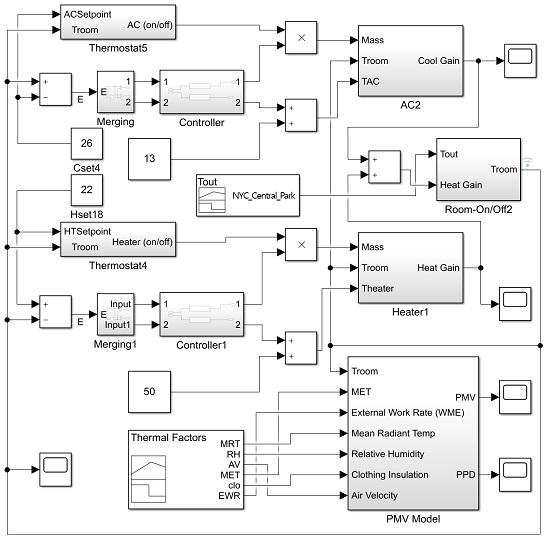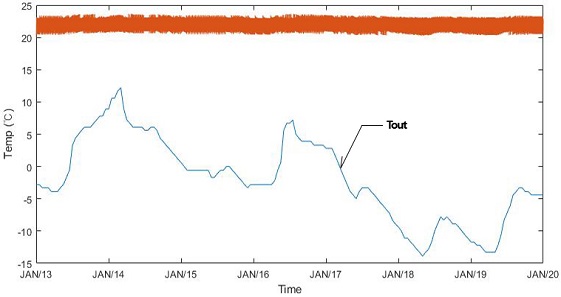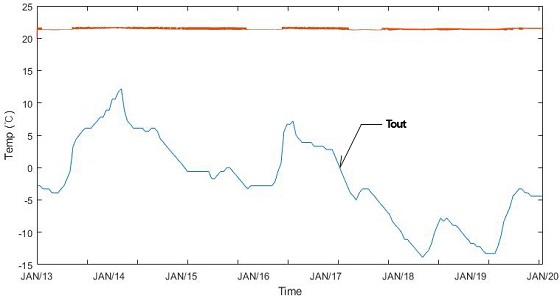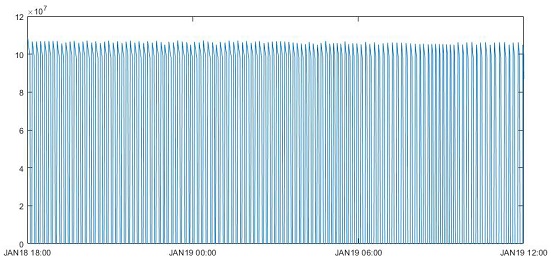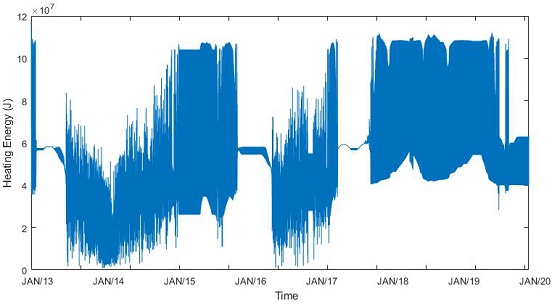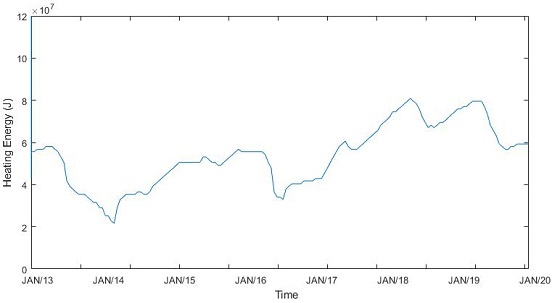
A Network-based Model to Improve the Constancy of Thermal Comfort and the Use of Thermal Energy during Sudden Changes in Outdoor Temperature
ⓒ 2022. KIEAE all rights reserved.
Abstract
As real-time indoor thermal data became available, the precision of building thermal control systems has been improved. However, resource usage has also increased. Therefore, examining the optimized point of energy use and thermal dissatisfaction for efficient control is imperative. This study aimed to find an energy-efficient thermal control strategy to suppress the increase in thermal dissatisfaction.
An adaptive control model utilizing an artificial neural network and the adjustment process of initial settings is proposed to examine the performance in controlling thermal air supply in terms of indoor thermal dissatisfaction and energy use. The standard deviation of each thermal dissatisfaction value and the weekly heating energy transfer are used for a clear comparison.
The proposed model successfully reduced indoor thermal dissatisfaction levels and energy use. Compared with the two deterministic models, the performance is improved in terms of the constancy of suppressing thermal dissatisfaction levels by 95.3% and the improvement of energy efficiency by 3.7%. The model can improve the sustainability of the old thermal system without replacing the overall system.
Keywords:
Thermal Dissatisfaction, Heating Energy, Control Process, Artificial Neural Network1. Indoor Thermal Environment Control
1.1. Background and Purpose
For effective control of the heating, venting, and air-conditioning (HVAC) system of buildings, various control methodologies related to improving the system design and operation strategies have been studied in the fields of architecture and thermal engineering. Particularly in mechanical control and system management, Mathematical and statistical techniques have been developed to optimize the operation and performance of boiler fuel supply, heat exchanger flow rate, air conditioning coils, and airflow control in ducts[1, 2]. Building and supplementing the internal algorithm for the diversified control model for the components of HVAC devices have been prioritized. The improvement in the control algorithm by correcting the main parameters and coefficients based on the experimental data has resulted in a continuous improvement in the control and energy efficiency of the existing system[1-3].
With rapid advances in the HVAC system and equipment, more precise control rules or algorithms are required to effectively cope with the indoor environment’s complex and sensitive operating conditions. In order to use data-centric statistical methods, hardware and software improvements that can process complex calculations are essential. Therefore, many buildings have been equipped with large-capacity computing control units. Fuzzy inference system (FIS) and artificial neural network (ANN) algorithms have been widely used to interpret these devices and their data input and calculate response strategies. It has been widely used in ambiguous and complex situations where calculating intuitive system operation methods is challenging and in areas that require deterministic data learning processes. FIS is a highly effective deterministic algorithm, requiring the identification of the indoor environment and a subjective decision by the user. In particular, various membership functions (MFs) of FIS have been developed and adopted to define appropriate output level values for fuel use, heat transfer fluid capacity, and the temperature of heating and cooling supplies[4]. The internal structure of MF in FIS dealing with ambiguous situations effectively investigates the performance of complex problems such as radiation, convection, ventilation, and penetration effects. Therefore, FIS algorithms have been frequently utilized in deterministic HVAC models to generate more reliable output signals by reflecting subjective and objective variables. In contrast, the ANN algorithm is widely used to deal with the hidden correlation of various variables where it is difficult to define a clear function. Prior to using this model, several variables in the regression model were often considered to have no clear correlation since there were no hardware or software systems that could effectively process the data volume. Various approaches for solving these complex problems have been devised by introducing ANN algorithms and high-performance computing systems. In particular, problems that were almost impossible to solve with general linear methods, such as how mechanical energy supply systems interact with building elements, have been solved effectively. Therefore, to review the hidden correlation of various variables, the ANN model uses various objective functions or algorithms for continuous upgrade and refinement of its internal structure[5, 6].
The HVAC system that controls the indoor environment becomes more complicated as the use and spatial systems of buildings become more complex. Accordingly, the evaluation of comfort, which used to rely on the subjective evaluation of users, has been developed in terms of mathematical and statistical approaches from various angles. Among them, predicted mean vote (PMV) or predicted percentage of dissatisfied (PPD) has been used as a representative method to increase the objectivity of data analysis of major thermal environmental elements constituting the indoor environment. The predicted percentage of dissatisfaction has been frequently used to compensate for the weakness of the intuitive judgment of the PMV index. These quantitative indices that reflect the thermal environmental conditions and user characteristics of the indoor space's physical elements have been applied to developing and improving genetic algorithms through experimental data and simulations. Studies have been conducted using several assumptions and design scenarios to define the rules of an internal control algorithm using FIS or ANN in a simplified model using a simulation tool. This relatively objective and quantitative approach allowed for effective comparison of the comfort levels in buildings as numerical indicators[7, 8]. The FIS and ANN algorithms were also adopted in the PMV model to complement the internal interaction between the simulation configuration and the operational process. To improve existing control rules, the specific thermal situation related to the mechanical supply system for heating and cooling air was analyzed by applying the numerical change due to several assumptions to the algorithm for certain thermal environmental elements directly associated with user behavior[9, 10]. Furthermore, various genetic algorithms were tested to improve the internal structure of the heating and cooling air supply control algorithm or the effectiveness of the ANN model. The structure of the HVAC control model has been improved through an adaptive model that assumes user behavior for connecting to the algorithm. Learning existing data and the statistical control model have been gradually supplemented[9, 10].
There has also been ongoing research on current calculation methods in response to the precision and complexity of simulation models to meet theoretical or practical conditions based on various tuning techniques. However, effective research to simultaneously enhance energy efficiency and control precision in unpredictable situations during the design and operation of an HVAC system has not been attempted from various angles. In addition, in a study comparing the indoor environmental control performance of the existing model and the improved model as well as the accompanying increase in energy consumption, an increase in the control errors or outliers while adjusting the time range and interval for performing the simulation was observed[9-11]. Therefore, it is essential to test whether the mid- to long-term adaptive model works effectively to suppress control errors that may occur in unpredictable changes in external temperature conditions that have not been trained in advance and boost the regression model’s validity.
1.2. Method and Scope of Research
The study aims to develop a control algorithm and model that maintains comfort homeostasis and effectively supplies thermal energy to maintain the indoor temperature at the set temperature according to the heat exchange occurring in the internal/external temperature difference while suppressing the increase in energy consumption that may occur. In comparison with the mechanical on/off mechanism of the existing thermostat model, it is intended to analyze how effective the control performance of the proposed model is in terms of energy consumption and interior comfort homeostasis maintenance for a given input value of external temperature that has not been given in the training data.
2. Models and Methods
2.1. Overview of the Indoor Thermal Environment Model
As for the main element constituting the simulation model of this study, the building in this study is a small single-story office facility with a floor area of 484m2 and a story height of 4.75m. The composition of walls and windows was based on the ASHRAE 90.1.2016 OfficeSmall template in EnergyPlus. The climatic conditions used in the simulation were meteorological data from January 13 to 20 of New York-Central Park 725033 (TMY3) on the EnergyPlus website Weather Data. The unpredictable situation of a sudden drop in temperature in the section where the temperature of the extremely cold season in New York is gradually rising was reviewed, particularly focusing on January 18 to 19, when the average daily temperature dropped by 10℃ or more. Table 1. shows some of the proposed model’s main numerical and thermal coefficients[12].
To test how to effectively respond to the temperature difference caused by internal/external heat exchange, the simulation tool’s building model was simplified to exterior walls, roofs, and windows, assuming there was no infiltration or ventilation effect through the exterior. Heat function models such as generators, HVAC systems, and air handling units for heating and cooling air supply were omitted.
The thermodynamic principle for calculating the load and air supply control follows the equation below, and the basic form of the model and function used is as follows[13]:
| (Eq. 1) |
where Qloss denotes the heat loss to the outdoors, Qgain denotes the heat gain from heating and cooling equipment, U denotes the internal energy, and t denotes the time.
The equation used to calculate the building envelope load (heat loss) is as follows:
| (Eq. 2) |
where T denotes the temperature, h denotes the heat transfer rate, k denotes the thermal transmittance, A denotes the envelope area, and D denotes the envelope thickness.
The ratio of internal energy is calculated as follows:
| (Eq. 3) |
where m denotes the mass, and Cv denotes the specific heat at constant volume.
The control model is compared and analyzed by calculating the change in the indoor temperature according to the change in the load at 1-minute intervals using the following equation:
| (Eq. 4) |
where Cp denotes the specific heat at constant pressure, ṁ denotes the mass flow rate, and Theater denotes the temperature of the supply air flowing into the room from the heating device.
To reflect the comfort level of indoor occupants in the simulation model, the following PMV and PPD equations are used[14]:
| (Eq. 5) |
| (Eq. 6) |
| (Eq. 7) |
where M denotes the metabolic rate, L denotes the heat load, Tcl denotes the average surface temperature of clothing, fcl denotes the DuBois surface area (Acl/AD) ratio, Rc denotes the effective thermal resistance of the garment, Ta denotes the indoor dry bulb temperature, Tc denotes the average radiant temperature, hc denotes the convective heat transfer coefficient, hr denotes the radiative heat transfer coefficient, Wa denotes the humidity, and Wsk denotes the saturated humidity at skin temperature.
2.2. Overview of the Control Model
The following three heating and cooling supply models are assumed based on the indoor load and comfort models.
First, the comparative model is a thermostat-based model where the operation starts or stops according to the set temperatures with a dead band range of ±1℃ (corresponding to ±2℉ in the US), most commonly applied in the actual thermostat model. For example, with the cooling temperature set at 26℃, the cooling air stops being supplied when the indoor temperature reaches 25℃. With the heating temperature set at 22 ℃, the heating air stops being supplied when the indoor temperature reaches 23℃.
Second, the FIS model has two inputs for supply air volume and temperature. This model uses the temperature difference and the amount of change as two inputs, which are specified as the temperature difference (E) between the set temperature (Tset) and the indoor temperature (Troom), and the amount of change ((ΔE) in the control model and the formula below[15].
| (Eq. 8) |
| (Eq. 9) |
When each value is entered into the triangle membership function below, the output is a value from 0 (0 %) to 1 (100 %) for air supply control, and -10℃ and +10℃ for air supply temperature control according to each ai, bi, and ci setting specified within MF, and sent to the supply air module in the simulation[15].
| (Eq. 10) |
Third, the ANN algorithm learns the calculated results using the seven climatic conditions (1A to 7A) provided by the International Energy Conservation Code for the two control models described above. In general, ANN algorithms include large classes of multiple structures aimed at optimal selection of a nonlinear mapping function x in the network[16, 17]. In order to control the air supply air quantity and temperature, the schematic ANN algorithm used in this study consists of two input layers, 10 hidden layers, and one output layer. According to the general ANN working principle, the sum (ni) of the input of x1 and xk for each neural network multiplied by the weight wki is used as the input to the activation function (g)[16, 17]. As a result of the simulation performed with 1,000 iterations per epoch, the statistical validity was confirmed for each, with R2 = 0.991504 for the air supply control ANN and R2 = 0.989927 for the air supply temperature control ANN.
2.3. Overview of the Simulation Model
Fig. 1. shows a simulation model composed of seven independent modules, i.e., signal generator (outdoor temperature and thermal environmental elements), thermostat, controller, AC, heater, room, and PMV. This model calculates the indoor temperature, heat exchange, and PMV values through simulation every minute. Among the thermal environmental elements for the efficient calculation of PMV values, the external work rate is assumed as 0, air velocity as 0.1 m/s, metabolic rate (MET) as 1.0, and clothing insulation (clo) as 1.2. Depending on the PMV result at that time, the adaptive process in the controller module lowers or raises the set temperature by 1℃.
3. Results and Analysis
3.1. Indoor Temperature (Troom) Control
Figs. 2.~4. compare the change in the outdoor temperature (Tout) in New York with the indoor temperature (Troom) controlled by the model (orange line at the top of Tout) from January 13 to 20. The characteristics of the different control models controlling the indoor temperature close to the set temperature (Tset) can be observed. As shown in Fig. 2., the thermostat model operating only within a predetermined temperature range operates with a relatively constant displacement throughout the simulation period. Enabling mechanical on/off operation regardless of any unpredictable changes in the outside temperature is an advantage of the thermostat model. In the FIS model shown in Fig. 3., the control fluctuation range is significantly suppressed throughout most of the simulation period. The FIS model is a switch model based on determinism. An operation similar to the thermostat operation is performed while reflecting the change in the outdoor temperature to reduce the change in the indoor temperature effectively.
Although effective response performance is observed even during the period from the morning of the 17th to the afternoon of the 19th, when the outdoor temperature drops rapidly, unlike the previous pattern, numerical results should be confirmed as to whether substantial discomfort and energy use suppression was performed at abrupt temperature changes below -5℃. Fig. 4. shows that the control algorithm of the ANN model is relatively effective. The ANN model demonstrates effective room temperature maintenance throughout the entire simulation period. This suggests that the ANN algorithm trained with the general outdoor temperature change and control method performs effective regression analysis despite a sudden, unexpected temperature change that greatly deviates from the range of existing data and that effective learning has been performed even with the results from the temperature control model in the thermostat, which is irrelevant to the existing thermodynamic equation.
3.2. Energy Control
Figs. 2.~4. showing the room temperature control pattern can be directly connected to the energy use of each model. Figs. 5.~7. show changes in the total heating energy supplied based on the heat transfer in the room module performed during indoor temperature control.
Fig. 5. shows a targeted part of the operation of the supply air process through the operation of the thermostat. When the indoor temperature falls below the set temperature, the thermostat sends a signal to start heating, using about 110MJ of energy to supply heat. In addition, the process of turning off the system as heating energy is no longer required upon reaching the set temperature is regularly repeated throughout the simulation period. Fig. 5. shows a targeted view of some sections among the control patterns performed by the thermostat at 1-minute intervals from 18:00 on January 18 to 12:00 on January 19.
In contrast, as shown in Fig. 6., the FIS model effectively suppresses the overshooting value caused by the dead band setting of the thermostat in the process of turning the system on and off. However, the peak demand is not significantly different from the result through the thermostat. The strength of the ANN algorithm is identified in these two areas.
As shown in Fig. 7., energy is supplied consistently in a pattern almost opposite to that of the outdoor temperature graph, which is expected to alleviate unnecessary overshooting, thereby leading to a significant economic effect on hardware design, maintenance, and repair of air conditioning and heating systems. In addition, irregular control did not appear from the 17th to the 19th, when an unpredictable temperature drop that had not been included in the training data appeared. The effect is confirmed by the maximum demand, which was about 80MJ, occurring in the early morning hours of the 18th and 19th. This suggests that the system can be designed to reduce energy use by about 20% compared to the thermostat model and FIS algorithm.
Tables 2. and 3. show the PPD standard deviation and weekly heating energy use values obtained through simulation. Regarding the thermal environmental index, PMV expresses the thermal sensation by distinguishing between positive and negative values. With no best-fit model that explains comfort, this study used the standard deviation of PPD values as a comparative index. As shown in Table 2., the ANN model minimizes changes in the indoor thermal environment by keeping the deviation of expected dissatisfaction low compared to the thermostat and FIS models. The fact that the standard deviation for PPD using a scale of 0 to 100 is only 0.37 suggests that precise control is being performed to suppress the rise and fall of the discomfort level effectively.
With the precise control of these ANN algorithms, an increase in energy consumption is generally expected. However, as shown in Table 3., the ANN model suppressed the daytime heating energy consumption by about 3.7% compared to the thermostat model. This can be interpreted as effectively offsetting the increase in energy use for precise control by suppressing the overshooting value that occurs when the room temperature reaches the set temperature and the maximum required value associated with it. Furthermore, the increase in the validity of the regression analysis model by supplementing the control error and the residual with the set value, which is likely to occur at a specific temperature in the data learning process, may have also been a factor in suppressing the unnecessary increase in energy use. This demonstrates the advantages of the ANN model in association with the maintenance of homeostasis in the indoor thermal environment and optimization of energy use, suggesting that it is possible to effectively control subjective human activities and sudden changes in outdoor temperature that deviate from expectations in various buildings.
4. Conclusion
This study attempted a comparative analysis of the control performance in maintaining indoor comfort homeostasis and energy use of a learning-based network algorithm with a thermostat model. Comparative analysis of the simulation results revealed that the quality of the indoor heating environment was continuously maintained compared to the simple mechanical on/off model using the existing thermostat, and the increase in energy consumption for this process was effectively suppressed. In particular, effective control performance was maintained even with the input of outdoor air data, including an unpredictable rapid temperature change, which was not used in the training of the network model.
Since the proposed model considers an extremely unpredictable situation in the outdoor temperature data for a certain period, the analysis of experimental models for climatic conditions, universally confirmed in reality, will be required. This can be used as an algorithm that responds to a sudden change in external temperature and suppresses the accompanying sudden increase in energy use in buildings with high energy demands, such as commercial complexes, hospitals, hotels, and airport terminals. For this, a building model based on a precise scenario that enables calculation of internal and external indoor environmental conditions and loads, as well as an additional climate model that can reflect various climate factors, including but not limited to the unpredictable changes in the external environment and the outside temperature, will be required. Furthermore, it will be possible to increase the statistical significance of the results by using more data to create a regression model based on past climate conditions.
Accordingly, subsequent studies will be conducted to supplement the model proposed in this study and increase the significance of the results. This includes sophisticated building modeling using building data of various uses and sizes, statistical models of qualitative user responses, and supplementation of control processes using genetic algorithms based on experimental data.
References
-
C. Blasco et al., Modelling and PID Control of HVAC System According to Energy Efficiency and Comfort Criteria. Sustainability in Energy and Buildings 2012, 12, pp.365-374.
[https://doi.org/10.1007/978-3-642-27509-8_31]

-
T. Kull, M. Thalfeldt and J. Kurnitski. PI Parameter Influence on Underfloor Heating Energy Consumption and Setpoint Tracking in nZEBs. Energies, 2020, 13.
[https://doi.org/10.3390/en13082068]

-
R. WaTalib, N. Nablim, W. Choi. Optimization-Based Data-Enabled Modeling Technique for HVAC Systems Components. Buildings 2020, 10(9).
[https://doi.org/10.3390/buildings10090163]

-
B. Paris et al., Hybrid PID-fuzzy control scheme for managing energy resources in buildings. Applied Soft Computing 2011, 11(8), pp.315-319.
[https://doi.org/10.1016/j.asoc.2011.05.052]

-
조혜운 외 4인, 시뮬레이션을 통한 융복합 히트펌프 시스템의 적응형 예측제어 알고리듬 성능평가, 한국: 한국생태환경건축학회 논문집, 제21권 제6호, 2021.12, pp.55-62.
H.W. Cho, et al. Performance Evaluation of an Adaptive & Predictive Control Algorithm for the Hybrid Heat Pump System Using Computer Simulation, Korea: KIEAE Journal, 21(6), 2021.12. pp.55-62. [ https://doi.org/10.12813/kieae.2021.21.6.055 ]
-
J.W. Moon, J. Ahn. Improving Sustainability of Ever-changing Building Spaces affected by Users’ Fickle Taste: A Focus on Human Comfort and Energy Use. 2020, Energy and Buildings, 208.
[https://doi.org/10.1016/j.enbuild.2019.109662]

-
J. Ahn. Thermal Control Performance of a Network-based Learning Controller in a Very Hot and Humid Area, Korea: KIEAE Journal, 21(1), 2021.02. pp.7-12.
[https://doi.org/10.12813/kieae.2021.21.1.007]

-
S. Yang, et al. A State-space Thermal Model Incorporating Humidity and Thermal Comfort for Model Predictive Control in Buildings. 2018, Energy and Buildings, pp.25-39.
[https://doi.org/10.1016/j.enbuild.2018.03.082]

-
J. Ahn, S. Cho. Anti-logic or common sense that can hinder machine’s energy performance: Energy and comfort control models based on artificial intelligence responding to abnormal indoor environments. 2017, Applied Energy, 204.
[https://doi.org/10.1016/j.apenergy.2017.06.079]

-
J. Ahn. Performance Analyses of Temperature Controls by a Network-Based Learning Controller for an Indoor Space in a Cold Area. 2020, Sustainability, 12(20).
[https://doi.org/10.3390/su12208515]

-
A. Afram and F. Janabi-Sharifi. Theory and Applications of HVAC Control Systems – A Review of Model Predictive Control (MPC). 2014, Building and Environment, 72, pp.343-355.
[https://doi.org/10.1016/j.buildenv.2013.11.016]

- National Institute of Building Science. Space Types. Whole Building Design Guide. [Online] National Institute of Building Science, May 8, 2020. [Citec: May 8, 2020.] https://www.wbdg.org/space-types, .
- T. Bergman, et al., Fundamentals of Heat and Mass Transfer. New York : Wiley, 2018. ES8-1-119-32042-5.
- INNOVA. Thermal Comfort. Naerum : INNOVA, 2002.
-
D. Petković, et al. Evaluation of the Most Influential Parameters of Heat Load in District Heating Systems. 2015, Energy and Buildings, pp.264-274.
[https://doi.org/10.1016/j.enbuild.2015.06.074]

-
P. Braspenning, F. Thuijsman and A. Weijters. Artificial Neural Networks. Berlin : Springer, 1995. ISBN 978-3-540-59488-8.
[https://doi.org/10.1007/BFb0027019]

- The University of Wisconsin Madison. A Basic Introduction To Neural Networks. The University of Wisconsin Madison. [Online] October 23, 2020. [Cited: October 23, 2020.] http://pages.cs.wisc.edu, .

